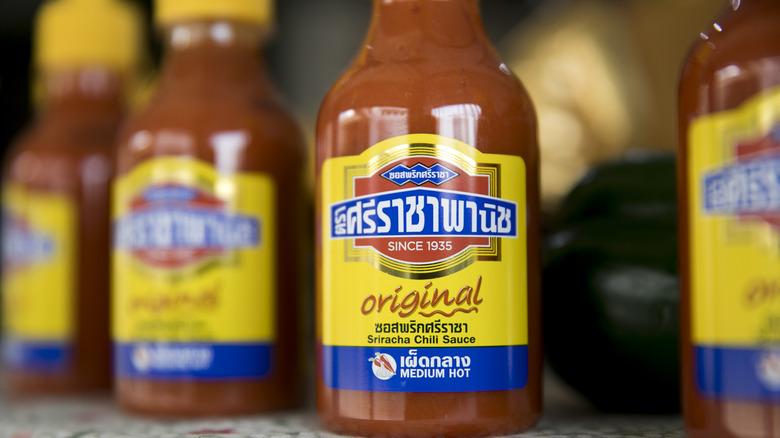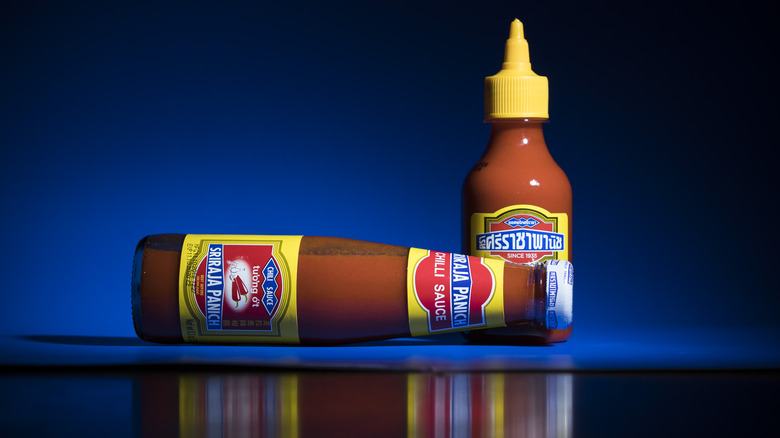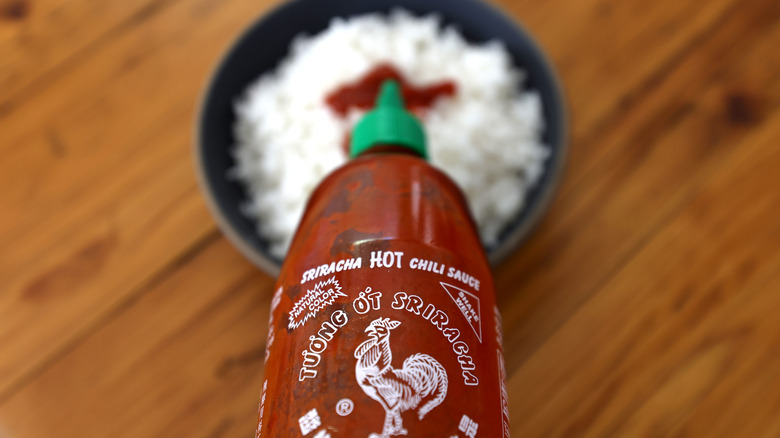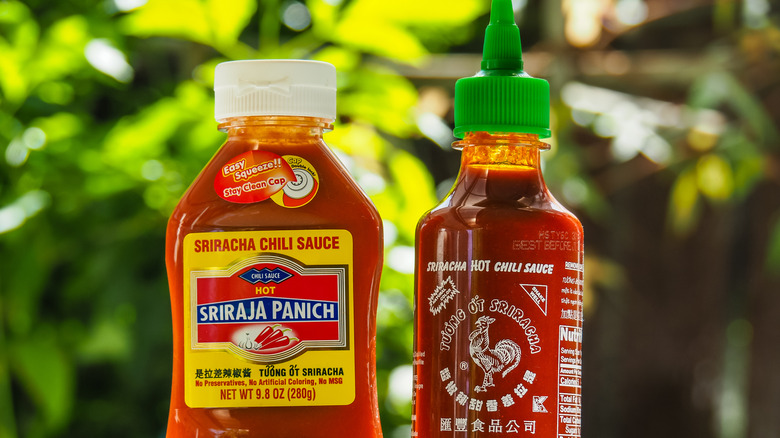What You Should Know About Sriraja Panich, The Original Sriracha Sauce
Sriracha is easily one of the most popular condiments out there, perfect for anyone who needs a bit of an added spicy kick to their meals. After all, there are countless food items that you can add the hot sauce to, from drizzling it over eggs for a spicier breakfast to utilizing it for a marinade for chicken or other meats, and so on.
Given its popularity, you may be surprised to learn that Sriracha is not the first, In reality, the Thai version, Sriraja Panich, came first. The sauce's main ingredient is red goat peppers, which are aged for a minimum of three months in order to ensure that the most flavor is brought out of them for the sauce. After the aging process, the chiles are mixed with the other ingredients: Thai garlic, sugar, vinegar, and sea salt. According to the sauce's official website, Sriraja Panich aims to cover the major tastes of spiciness, sourness, sweetness, and saltiness. The sauce is also completely natural — the process doesn't include anything artificial, such as preservatives or MSG.
Sriraja Panich dates back 80 years
Sriraja Panich dates back about 80 years ago and was created by Ms. Thanom Chakkapak, who wanted to make a sauce for her family and friends in the seaside district of Si Racha in Thailand. According to the website, Chakkapak originally intended for it to be eaten with fresh seafood, either grilled or fried. After those close to Chakkapak fell in love with the sauce, they encouraged her to sell it, leading it to become Thailand's best-selling chile sauce. In the '80s, Chakkapak sold the sauce to a big Thai food company called Thai Theparos Food Products.
However, while Chakkapak is usually credited as the creator, Chakkapak's granddaughter, Saowanit Trikityanukul, told NPR that the original recipe actually came from her great-grandfather (Chakkapak's father), Gimsua Timkrajang. From what Trikityanukul has heard, Timkrajang would travel a lot and could never find the perfect sauce — one that was sweet, salty, and sour. Trikityanukul can also attest to how arduous the process is — it would take weeks or sometimes months to prepare one batch.
Nowadays, Sriraja Panich is still used with fresh seafood but has also become more widely used in other dishes as well (similar to how versatile Sriracha has become in America). In Thailand, the sauce is also used on rice or eggs, such as a Thai omelet. In other cases, Sriraja Panich is even mixed into the sauce for a noodle dish, such as pad Thai.
How Sriracha became big in the US — and what Chakkapak's family thinks
The Sriracha that we know today was created by Vietnamese native David Tran, who started working on his own recipe after immigrating to California. He named it Sriracha as an homage to the sauce that inspired his own recipe: Sriraja Panich. The business started quite small but grew substantially through the '80s and '90s. By the mid-2000s, Sriracha was now being sold in supermarkets and showing up in restaurants. It wasn't long before consumers started getting creative about what they put the sauce on. And naturally, other companies tried to come up with their own versions of Sriracha. But if you're looking for a Sriracha alternative, you want to try seeking out the original — Sriraja Panich.
As for what Ms. Thanom Chakkapak's family thinks about the success of Sriracha, Saowanit Trikityanukul told NPR that she understands it's just business. She said, "He saw an opportunity and made his own business ... Champagne is one kind of drink. Sriracha is one kind of sauce." Plus, Trikityanukul insists that the taste of Sriracha is vastly different than the taste of the original. And according to Trikiyanukul, Sriracha doesn't have the blend of flavors that made the original stand out. Rather, it's just spicy. She said, "It's not tasty. It's not mixed together properly. There's only one taste."
Sriraja Panich has had a hard time breaking into the US
Given the success of Sriracha, it hasn't exactly been easy for Sriraja Panich to make it big in the U.S. Speaking to NPR, Varanya Winyarat, deputy managing director of Thaitheparos (the company that bought Sriraja Panich from Chakkapak's family about 40 years ago) explained that it's difficult to get going in America when everyone is used to the taste of Sriracha (which, as Trikityanukul explained, is very different). Because of this, they've taken to only selling in Asian supermarkets, although Winyarat (as of 2019, at the time of the NPR interview) thinks they should put more money into advertising as an attempt to make it in the mainstream market.
Back to the taste difference, Winyarat told NPR, "I think I have to educate them first what the sauce should taste like. You have to educate them about the basics of the taste first. Then I think they would understand."
Meanwhile, Sriracha is now being sold in Thailand, meaning that the two sauces compete with one another, even in Sriraja Panich's homeland. However, Sriracha has yet to be easily embraced in Thailand, with many consumers having strong feelings about the sauce trying to take the place of the original Sriraja Panich. But Winyarat isn't worried about Srirarcha's place in Thailand. She told NPR, "Thai people understand the real taste."



